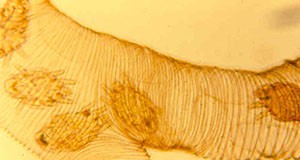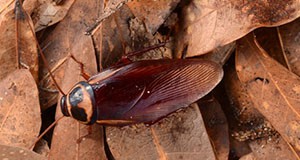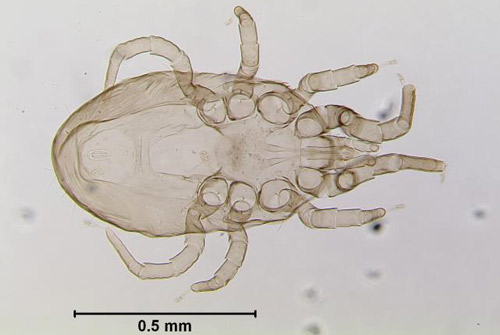Tracheal mites are parasites of the western honey bee and negatively impact the health and productivity of an infested colony. This 6-page fact sheet details the method of dissecting honey bees in order to diagnose tracheal mites. Written by John Bonkowski, Ashley N. Mortensen, and James D Ellis, and published by the UF Department of Entomology and Nematology, January 2015.
http://edis.ifas.ufl.edu/in1072
Tag: Entomology and Nematology Department
Australian cockroach Periplaneta australasiae Fabricius (Insecta: Blattodea: Blattidae)
Australian cockroaches are the most common outdoor cockroach in southern Florida. Though they typically stay outdoors, Australian cockroaches may also venture inside and live among humans. This 4-page fact sheet covers the Australian cockroach’s distribution and habitat, biology, medical risks to humans, and management as a pest. Written by Shiyao Jiang and Phillip E. Kaufman, and published by the UF Department of Entomology and Nematology, April 2015.
http://edis.ifas.ufl.edu/in1088
Observation Bee Hives
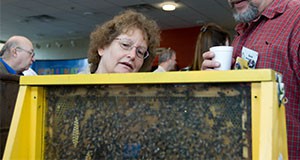
The use of observation bee hives continues to interest a variety of people. This is not surprising. The observation hive is one of the primary research and educational tools in apiculture. It is both educational and entertaining. Observation bee hives can be used to enhance public relations and marketing programs. But a great deal of time and energy is needed to set up a hive and keep it going. Maintenance can be expensive and time consuming, especially if the hive is to be used as a permanent display for the general public. This 3-page fact sheet provides sources for building observation hives and tips for maintenance. Written by David Hall, James D. Ellis, and Malcolm Sanford, and published by the UF Department of Entomology and Nematology, March 2015. (UF/IFAS photo by Tyler Jones)
http://edis.ifas.ufl.edu/mg320
Sample Pollination Agreement
 The key to a prospering pollination service is proper promotion, honest, quality service, and a written contract. This contract would detail the expectations of both the beekeeper and the grower. This 4-page fact sheet provides a suggested pollination agreement. Written by Malcolm T. Sanford, Jeanette Klopchin, and James Ellis, and published by the UF Department of Entomology and Nematology, March 2015. (UF/IFAS Photo: Thomas Wright)
The key to a prospering pollination service is proper promotion, honest, quality service, and a written contract. This contract would detail the expectations of both the beekeeper and the grower. This 4-page fact sheet provides a suggested pollination agreement. Written by Malcolm T. Sanford, Jeanette Klopchin, and James Ellis, and published by the UF Department of Entomology and Nematology, March 2015. (UF/IFAS Photo: Thomas Wright)
http://edis.ifas.ufl.edu/aa169
Thrips in Florida Strawberry Crops
 Strawberries grown in Florida are attacked by several pests, including flower thrips. Western flower thrips and common blossom thrips (both invasive) can cause damage to strawberries in Florida; but, while the native Florida flower thrips is commonly found in strawberry blossoms, it hasn’t been established that it can cause economic damage to strawberry. This 9-page fact sheet describes thrips damage, characteristics to distinguish among the three species, and methods of control. Written by Jeff D. Cluever, Hugh A. Smith, Joe E. Funderburk, and Galen Frantz, and published by the UF Department of Entomology and Nematology, January 2015. (Photo: H. A. Smith)
Strawberries grown in Florida are attacked by several pests, including flower thrips. Western flower thrips and common blossom thrips (both invasive) can cause damage to strawberries in Florida; but, while the native Florida flower thrips is commonly found in strawberry blossoms, it hasn’t been established that it can cause economic damage to strawberry. This 9-page fact sheet describes thrips damage, characteristics to distinguish among the three species, and methods of control. Written by Jeff D. Cluever, Hugh A. Smith, Joe E. Funderburk, and Galen Frantz, and published by the UF Department of Entomology and Nematology, January 2015. (Photo: H. A. Smith)
http://edis.ifas.ufl.edu/in1078
Western Flower Thrips (Frankliniella occidentalis [Pergande])
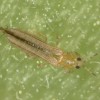 One of many species of thrips found in Florida, Frankliniella occidentalis is a pest of several crops throughout Florida and the world, causing injury by feeding and by transmission of plant viruses. This 8-page fact sheet was written by Jeffrey D. Cluever, Hugh A. Smith, Joseph E. Funderburk, and Galen Frantz, and published by the UF Department of Entomology and Nematology, April 2015. (Photo: Lyle Buss)
One of many species of thrips found in Florida, Frankliniella occidentalis is a pest of several crops throughout Florida and the world, causing injury by feeding and by transmission of plant viruses. This 8-page fact sheet was written by Jeffrey D. Cluever, Hugh A. Smith, Joseph E. Funderburk, and Galen Frantz, and published by the UF Department of Entomology and Nematology, April 2015. (Photo: Lyle Buss)
http://edis.ifas.ufl.edu/in1089
Sting Nematode Belonolaimus longicaudatus Rau (Nematoda: Tylenchida: Belonolaimidae)
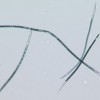 Among the most destructive plant-parasitic nematodes to a wide range of plants, Belonolaimus longicaudatus damages plant roots. When the plants cannot take up water and nutrients from the soil, they become stunted, wilt, and with severe infestation, die. Florida is considered to be the point-of-origin for Belonolaimus longicaudatus and therefore this nematode exhibits a great deal of diversity in morphology, host preference, and genetics in our region. This 6-page fact sheet was written by W. T. Crow, and published by the UF Department of Entomology and Nematology, March 2015. (Photo W. T. Crow, UF/IFAS)
Among the most destructive plant-parasitic nematodes to a wide range of plants, Belonolaimus longicaudatus damages plant roots. When the plants cannot take up water and nutrients from the soil, they become stunted, wilt, and with severe infestation, die. Florida is considered to be the point-of-origin for Belonolaimus longicaudatus and therefore this nematode exhibits a great deal of diversity in morphology, host preference, and genetics in our region. This 6-page fact sheet was written by W. T. Crow, and published by the UF Department of Entomology and Nematology, March 2015. (Photo W. T. Crow, UF/IFAS)
http://edis.ifas.ufl.edu/in1080
Anagyrus pseudococci Girault (Insecta: Hymenoptera: Encyrtidae)
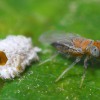 Anagyrus pseudococci is an economically important biological control agent commonly used against the vine mealybug (which infests wine grapes) and the citrus mealybug. It is a solitary, internal parasitoid and lays one egg per host, with the larva developing inside the host’s body. The wasps may be commercially reared and distributed inside mummies, and they will emerge within 1-5 days after delivery. Application involves placing a bottle containing the mummies in a dry spot of the crop and allowing the adults to emerge. This 5-page fact sheet was written by Theresa Chormanski and Ronald D. Cave, and published by the UF Department of Entomology and Nematology, March 2015. (Photo: Kent M. Dane)
Anagyrus pseudococci is an economically important biological control agent commonly used against the vine mealybug (which infests wine grapes) and the citrus mealybug. It is a solitary, internal parasitoid and lays one egg per host, with the larva developing inside the host’s body. The wasps may be commercially reared and distributed inside mummies, and they will emerge within 1-5 days after delivery. Application involves placing a bottle containing the mummies in a dry spot of the crop and allowing the adults to emerge. This 5-page fact sheet was written by Theresa Chormanski and Ronald D. Cave, and published by the UF Department of Entomology and Nematology, March 2015. (Photo: Kent M. Dane)
http://edis.ifas.ufl.edu/in1081
Zombie Fly (suggested common name) Apocephalus borealis Brues (Insecta: Diptera: Phoridae)
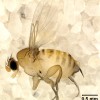 The zombie fly is primarily a parasitoid of bumble bees and wasps in North America. In 2012, Dr. John Hafernik and his colleagus at San Francisco State University discovered that Apocephalus borealis also parasitizes honey bees. Parasitized honey bees show zombie-like behavior by leaving their hives at night and are often attracted to nearby lights where they show disoriented behavior and die in a few hours. This 5-page fact sheet was written by Nicole A. Casuso, Ashley N. Mortensen, and James D. Ellis, and published by the UF Department of Entomology and Nematology, October 2014. (Photo: Jessica Andrieux, CC SA-BY 2.5)
The zombie fly is primarily a parasitoid of bumble bees and wasps in North America. In 2012, Dr. John Hafernik and his colleagus at San Francisco State University discovered that Apocephalus borealis also parasitizes honey bees. Parasitized honey bees show zombie-like behavior by leaving their hives at night and are often attracted to nearby lights where they show disoriented behavior and die in a few hours. This 5-page fact sheet was written by Nicole A. Casuso, Ashley N. Mortensen, and James D. Ellis, and published by the UF Department of Entomology and Nematology, October 2014. (Photo: Jessica Andrieux, CC SA-BY 2.5)
http://edis.ifas.ufl.edu/in1063
Chicken Mite (other common names: poultry red mite, roost mite) Dermanyssus gallinae (De Geer) (Arachnida: Acari: Dermanyssidae)
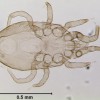 The chicken mite affects egg-laying hens in many parts of the world, including Europe, Japan, China, and the United States. Although Dermanyssus gallinae affects birds in many regions, it is most prevalent in European countries, where egg industry losses are estimated at $177 million per year. It is a known vector for the St. Louis encephalitis virus, as well as other illnesses, such as fowl pox virus, Newcastle virus, and fowl cholera. In the United States, Dermanyssus gallinae is rarely found in caged-layer operations and is more commonly found in breeder farms. This 3-page fact sheet was written by Ethan Carter and Jennifer L. Gillett-Kaufman, and published by the UF Department of Entomology and Nematology, December 2015. (Photo credit: Lyle J. Buss, University of Florida)
The chicken mite affects egg-laying hens in many parts of the world, including Europe, Japan, China, and the United States. Although Dermanyssus gallinae affects birds in many regions, it is most prevalent in European countries, where egg industry losses are estimated at $177 million per year. It is a known vector for the St. Louis encephalitis virus, as well as other illnesses, such as fowl pox virus, Newcastle virus, and fowl cholera. In the United States, Dermanyssus gallinae is rarely found in caged-layer operations and is more commonly found in breeder farms. This 3-page fact sheet was written by Ethan Carter and Jennifer L. Gillett-Kaufman, and published by the UF Department of Entomology and Nematology, December 2015. (Photo credit: Lyle J. Buss, University of Florida)
http://edis.ifas.ufl.edu/in1070
Tawny Crazy Ant (previously known as Caribbean crazy ant) Nylanderia (formerly Paratrechina) fulva (Mayr) (Insecta: Hymenoptera: Formicidae: Formicinae)
 Nylanderia fulva is part of a group of ants referred to as “crazy ants” due to their quick and erratic movements. It has been reported from 27 counties of Florida and 27 counties of Texas, as well as from Louisiana, Mississippi, Alabama and Georgia. Huge number of workers in infested areas can make human activities uncomfortable and difficult. They can infest sidewalks, buildings and gardens, and damage phone lines, air conditioning units and computers. They have killed honey bee larvae and used the hives as their nests, and are even displacing red imported fire ants where the two populations overlap in Texas. This 5-page fact sheet was written by Shweta Sharma, John Warner, and Rudolph H. Scheffrahn, and published by the UF Department of Entomology and Nematology, December 2014. (Photo: Lyle Buss, UF/IFAS)
Nylanderia fulva is part of a group of ants referred to as “crazy ants” due to their quick and erratic movements. It has been reported from 27 counties of Florida and 27 counties of Texas, as well as from Louisiana, Mississippi, Alabama and Georgia. Huge number of workers in infested areas can make human activities uncomfortable and difficult. They can infest sidewalks, buildings and gardens, and damage phone lines, air conditioning units and computers. They have killed honey bee larvae and used the hives as their nests, and are even displacing red imported fire ants where the two populations overlap in Texas. This 5-page fact sheet was written by Shweta Sharma, John Warner, and Rudolph H. Scheffrahn, and published by the UF Department of Entomology and Nematology, December 2014. (Photo: Lyle Buss, UF/IFAS)
http://edis.ifas.ufl.edu/in1071
Fiddlewood leafroller, seagrape moth (suggested common names) Epicorsia oedipodalis (Guenée, 1854) (Lepidoptera: Ditrysia: Pyraloidea: Pyralidae: Pyraustinae)
 These caterpillars roll up leaves of the host plants and use the rolled leaves as larval retreats and locations for pupal cocoons. Although these leaf-eating pests do no permanent damage, they can completely defoliate fiddlewood, a Florida native that can form a large shrub or small tree. The shrub simply puts out a new flush of leaves. The larvae themselves are valuable food source for baby birds during the spring dry season in Florida. This 4-page fact sheet was written by William H. Kern, and published by the UF Department of Entomology and Nematology, February 2015. (Photo:W.H. Kern, Jr., UF/IFAS/FLREC)
These caterpillars roll up leaves of the host plants and use the rolled leaves as larval retreats and locations for pupal cocoons. Although these leaf-eating pests do no permanent damage, they can completely defoliate fiddlewood, a Florida native that can form a large shrub or small tree. The shrub simply puts out a new flush of leaves. The larvae themselves are valuable food source for baby birds during the spring dry season in Florida. This 4-page fact sheet was written by William H. Kern, and published by the UF Department of Entomology and Nematology, February 2015. (Photo:W.H. Kern, Jr., UF/IFAS/FLREC)
http://edis.ifas.ufl.edu/in1079
Squash Vine Borer Melittia cucurbitae (Harris) (Insecta: Lepidoptera: Sesiidae)
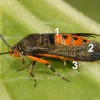 Squash vine borer is a moth species that is active during the day (diurnal). The larvae complete their growth and development on wild and domesticated species of the genus Cucurbita. Once only considered a nuisance to commercial growers, with the expansion of cucurbit production in the United States over the last decade, the squash vine borer has become a pest of economic importance. This 5-page fact sheet was written by Eutychus Kariuki and Jennifer L. Gillett-Kaufman, and published by the UF Department of Entomology and Nematology, December 2014. (Photo: Lyle J. Buss, UF/IFAS)
Squash vine borer is a moth species that is active during the day (diurnal). The larvae complete their growth and development on wild and domesticated species of the genus Cucurbita. Once only considered a nuisance to commercial growers, with the expansion of cucurbit production in the United States over the last decade, the squash vine borer has become a pest of economic importance. This 5-page fact sheet was written by Eutychus Kariuki and Jennifer L. Gillett-Kaufman, and published by the UF Department of Entomology and Nematology, December 2014. (Photo: Lyle J. Buss, UF/IFAS)
http://edis.ifas.ufl.edu/in1068
Rice Bug (suggested common name) Leptocorisa acuta (Thunberg) (Insecta: Hemiptera: Alydidae)
 Broad-headed bugs belong to a well-known but relatively small family of plant-feeding true bugs, usually seen feeding on the foliage and flowers of leguminous and graminaceous crops. Leptocorisa acuta (Thunberg) can be found on many crop plants in the family Poaceae (grasses), especially rice, and is a reported pest of economic significance in rice-producing countries like India, Australia, and China. This 3-page fact sheet was written by Amelio Chi Serrano, Russell F. Mizell, III, and Morgan A. Byron, and published by the UF Department of Entomology and Nematology, December 2014. (Photo: Lary E. Reeves, UF/IFAS)
Broad-headed bugs belong to a well-known but relatively small family of plant-feeding true bugs, usually seen feeding on the foliage and flowers of leguminous and graminaceous crops. Leptocorisa acuta (Thunberg) can be found on many crop plants in the family Poaceae (grasses), especially rice, and is a reported pest of economic significance in rice-producing countries like India, Australia, and China. This 3-page fact sheet was written by Amelio Chi Serrano, Russell F. Mizell, III, and Morgan A. Byron, and published by the UF Department of Entomology and Nematology, December 2014. (Photo: Lary E. Reeves, UF/IFAS)
http://edis.ifas.ufl.edu/in1067
Wellsina Mite Hemicheyletia wellsina (De Leon) (Arachnida: Acari: Cheyletidae)
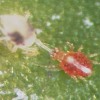 This predatory mite was recently discovered in an unsprayed greenhouse at the University of Florida, Gainesville, living on Phalaenopsis and Dendrobium orchids, and assumed to be feeding on orchid pests such as spider mites, tenuipalpid mites, and mealybugs that were present on the orchids. Because there was no published information on this species as a natural enemy of orchid pests, colonies were initiated here to study its biology, maintained on two-spotted spider mite prey. Hemicheyletia wellsina does not appear likely to be an effective natural enemy in agricultural crops as an introduced predator, but could be beneficial in natural biological control in natural ecosystems, where pest densities are lower. This 5-page fact sheet was written by Haleigh A. Ray and Marjorie A. Hoy, and published by the UF Department of Entomology and Nematology, December 2014. (Photo: Haleigh Ray, UF/IFAS)
This predatory mite was recently discovered in an unsprayed greenhouse at the University of Florida, Gainesville, living on Phalaenopsis and Dendrobium orchids, and assumed to be feeding on orchid pests such as spider mites, tenuipalpid mites, and mealybugs that were present on the orchids. Because there was no published information on this species as a natural enemy of orchid pests, colonies were initiated here to study its biology, maintained on two-spotted spider mite prey. Hemicheyletia wellsina does not appear likely to be an effective natural enemy in agricultural crops as an introduced predator, but could be beneficial in natural biological control in natural ecosystems, where pest densities are lower. This 5-page fact sheet was written by Haleigh A. Ray and Marjorie A. Hoy, and published by the UF Department of Entomology and Nematology, December 2014. (Photo: Haleigh Ray, UF/IFAS)
http://edis.ifas.ufl.edu/in1066
Yellowmargined Leaf Beetle: A Pest of Cole Crops
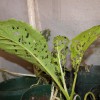 The yellowmargined leaf beetle is a pest of cole or cruciferous crops that is native to South America. Since first reported in Mobile, Alabama, in 1947, the beetle has spread throughout the Gulf Coast from Texas to Florida and up into Georgia and North Carolina. It has also been reported from Illinois and California. Not considered a major pest in conventionally grown cruciferous crops because it is susceptible to a wide range of insecticides, it poses a significant threat to the growing organic industry in the southeastern United States. It is a particular problem on Asian greens such as mizuna, mibuna, and napa cabbage, as well as on other high-value cruciferous crops like turnip, mustard, and watercress. This 4-page fact sheet was written by Elena M. Rhodes and and Oscar E. Liburd, and published by the UF Department of Entomology and Nematology, September 2014.
The yellowmargined leaf beetle is a pest of cole or cruciferous crops that is native to South America. Since first reported in Mobile, Alabama, in 1947, the beetle has spread throughout the Gulf Coast from Texas to Florida and up into Georgia and North Carolina. It has also been reported from Illinois and California. Not considered a major pest in conventionally grown cruciferous crops because it is susceptible to a wide range of insecticides, it poses a significant threat to the growing organic industry in the southeastern United States. It is a particular problem on Asian greens such as mizuna, mibuna, and napa cabbage, as well as on other high-value cruciferous crops like turnip, mustard, and watercress. This 4-page fact sheet was written by Elena M. Rhodes and and Oscar E. Liburd, and published by the UF Department of Entomology and Nematology, September 2014.
http://edis.ifas.ufl.edu/in1049
Robbing Behavior in Honey Bees
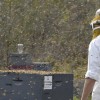 Western honey bee workers can invade and steal honey/nectar from other colonies or sugar/corn syrup from feeders used to deliver syrup to other colonies. This is called “robbing” behavior. Robbing behavior typically involves the collection of nectar and honey, but not pollen or brood. Some beekeepers report that robbing bees may steal wax or propolis from other hives, but there is not much data available on this occurrence. Robbing behavior can escalate quickly from just a few bees robbing other colonies to a massive frenzy of bees robbing many colonies in an apiary. This 3-page fact sheet was written by Ryan Willingham, Jeanette Klopchin, and James Ellis, and published by the UF Department of Entomology and Nematology, February 2015. (Photo Credit: UF/HBREL)
Western honey bee workers can invade and steal honey/nectar from other colonies or sugar/corn syrup from feeders used to deliver syrup to other colonies. This is called “robbing” behavior. Robbing behavior typically involves the collection of nectar and honey, but not pollen or brood. Some beekeepers report that robbing bees may steal wax or propolis from other hives, but there is not much data available on this occurrence. Robbing behavior can escalate quickly from just a few bees robbing other colonies to a massive frenzy of bees robbing many colonies in an apiary. This 3-page fact sheet was written by Ryan Willingham, Jeanette Klopchin, and James Ellis, and published by the UF Department of Entomology and Nematology, February 2015. (Photo Credit: UF/HBREL)
http://edis.ifas.ufl.edu/in1064
Urban Pests and Pest Management
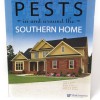 The warm southern states provide an ideal environment for a wide variety of pests — and because almost everyone has problems with pests, most urban areas are sprayed with pesticides. 30 to 40 percent of pesticide use is in urban areas, but most pesticide applications are unnecessary and can result in environmental contamination and human exposure to pesticides. This 5-page fact sheet from Pests in and around the Southern Home introduces integrated pest management practices that can help reduce pesticide use in the home. Written by P.G. Koehler, and published by the UF Department of Entomology and Nematology, October 2013.
The warm southern states provide an ideal environment for a wide variety of pests — and because almost everyone has problems with pests, most urban areas are sprayed with pesticides. 30 to 40 percent of pesticide use is in urban areas, but most pesticide applications are unnecessary and can result in environmental contamination and human exposure to pesticides. This 5-page fact sheet from Pests in and around the Southern Home introduces integrated pest management practices that can help reduce pesticide use in the home. Written by P.G. Koehler, and published by the UF Department of Entomology and Nematology, October 2013.
http://edis.ifas.ufl.edu/in1073
Wedge-Shaped Beetles (suggested common name) Ripiphorus spp. (Insecta: Coleoptera: Ripiphoridae)
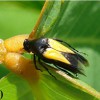 Ripiphoridae are a family of unusual parasitic beetles that are thought to be related to tumbling flower beetles and blister beetles. They parasitize bees and wasps, roaches, and wood-boring beetles, but specific hosts for many ripiphorid species are unknown. Their secretive life cycle makes an assessment of their economic and ecological impact very difficult. Additional research is necessary to determine the abundance and impact of Ripiphorus species. This 4-page fact sheet was written by David Owens, Ashley N. Mortensen, Jeanette Klopchin, William Kern, and Jamie D. Ellis, and published by the UF Department of Entomology and Nematology, December 2014.
Ripiphoridae are a family of unusual parasitic beetles that are thought to be related to tumbling flower beetles and blister beetles. They parasitize bees and wasps, roaches, and wood-boring beetles, but specific hosts for many ripiphorid species are unknown. Their secretive life cycle makes an assessment of their economic and ecological impact very difficult. Additional research is necessary to determine the abundance and impact of Ripiphorus species. This 4-page fact sheet was written by David Owens, Ashley N. Mortensen, Jeanette Klopchin, William Kern, and Jamie D. Ellis, and published by the UF Department of Entomology and Nematology, December 2014.
http://edis.ifas.ufl.edu/in1069
Flower Thrips in Blackberries in Florida
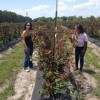 Blackberry production is a small but growing industry in the state of Florida. Their numerous health benefits make them a good choice for Florida growers who want to diversify from traditional crops such as strawberries. Several potential pest insects and mites have been found on blackberries in Florida, but the two most likely to become key pests are stink bugs and flower thrips. This 3-page fact sheet provides information on flower thrips identification, monitoring and management for blackberries. Written by Oscar E. Liburd, Elena M. Rhodes, Elke Weibelzahl, and Sara E. Brennan, and published by the UF Department of Entomology and Nematology, November 2014.
Blackberry production is a small but growing industry in the state of Florida. Their numerous health benefits make them a good choice for Florida growers who want to diversify from traditional crops such as strawberries. Several potential pest insects and mites have been found on blackberries in Florida, but the two most likely to become key pests are stink bugs and flower thrips. This 3-page fact sheet provides information on flower thrips identification, monitoring and management for blackberries. Written by Oscar E. Liburd, Elena M. Rhodes, Elke Weibelzahl, and Sara E. Brennan, and published by the UF Department of Entomology and Nematology, November 2014.
http://edis.ifas.ufl.edu/in1060
